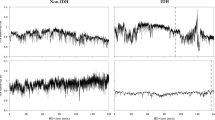Abstract
Introduction
Haemorrhage is associated with changes in the cardiac autonomic drive which begins during early stages of mild haemorrhage. The knowledge of chronology of the autonomic changes at smaller timescale during the period of haemorrhage can help identify the primary autonomic parameter which signals the institution of cardiovascular reflex mechanisms.
Aim
To evaluate the heart rate variability in 2-min sequential segments with one minute overlap during and after the period of mild haemorrhage (450 ml) using blood donation as a model of acute blood loss.
Methods
47 male blood donors who had volunteered for blood donation were recruited for the study. Continuous lead II ECG was recorded before the start of the blood donation (5 min), during the period of the blood donation (~ 5–7 min) and after blood donation (5 min). The parasympathetic and sympathetic drive to heart was estimated by measures of heart rate variability in time and frequency domain.
Results
A significant decrease in the parameters assessing parasympathetic drive i.e., normalised High frequency (HFn) and NN50 (Number of pairs of adjacent NN intervals differing by more than 50 ms) and pNN50 (NN50 divided by the total number of all NN Intervals) was observed during blood donation at 3–5 min, as compared to baseline. An increase in parameters associated with sympathetic drive i.e., normalised low frequency (LFn) was observed only in the post donation period at 2–3 min. A significant rise in LF/HF ratio which is a marker of sympatho vagal balance was observed at 4–5 min during blood donation when compared to baseline.
Conclusion
The initial cardiac autonomic change during mild haemorrhage is withdrawal of parasympathetic drive, followed by an increase in sympathetic tone which occurs much later.


Similar content being viewed by others
References
Gutierrez G, Reines HD, Wulf-Gutierrez ME. Clinical review: hemorrhagic shock. Crit Care. 2004;8:373–81.
Fortrat JO, Nasr O, Duvareille M, Gharib C. Human cardiovascular variability, baroreflex and hormonal adaptations to a blood donation. Clin Sci (Lond). 1998;95:269–75.
Zöllei E, Paprika D, Makra P, Gingl Z, Vezendi K, Rudas L. Human autonomic responses to blood donation. Auton Neurosci. 2004;110:114–20.
Middleton PM, Chan GSH, O’Lone E, Steel E, Carroll R, Celler BG, et al. Spectral analysis of finger photoplethysmographic waveform variability in a model of mild to moderate haemorrhage. J Clin Monit Comput. 2008;22:343–53.
Johnson BD, Van Helmond N, Curry TB, Van Buskirk CM, Convertino VA, Joyner MJ. Reductions in central venous pressure by lower body negative pressure or blood loss elicit similar hemodynamic responses. Appl Physiol. 2014;117:131–41.
Cooke WH, Ryan KL, Convertino VA. Lower body negative pressure as a model to study progression to acute hemorrhagic shock in humans. J Appl Physiol. 2004;96:1249–61.
Fu Q, Shibata S, Hastings JL, Prasad A, Palmer MD, Levine BD. Evidence for unloading arterial baroreceptors during low levels of lower body negative pressure in humans. Am J Physiol. 2015;296:1–11.
Floras JS, Butler GC, Ando S, Brooks SC, Pollard MJ, Picton P, et al. Differential sympathetic nerve and heart rate spectral effects of nonhypotensive lower body negative pressure. Am J Physiol. 2001;5:468–75.
Hisdal J, Toska K, Flatebø T. Onset of mild lower body negative pressure induces transient change in mean arterial pressure in humans Stroke volume Cardiopulmonary baroreceptors. Eur J Appl Physiol. 2002;87:251–6.
Yadav K, Singh A, Jaryal AK, Coshic P, Chatterjee K, Deepak KK. Modulation of cardiac autonomic tone in non-hypotensive hypovolemia during blood donation. J Clin Monit Comput. 2017;31:739–46.
Task Force. Heart rate variability. Standards of measurement, physiological interpretation, and clinical use. Task Force of the European Society of Cardiology and the North American Society of Pacing and Electrophysiology. Eur Heart J. 1996;17:354–81.
Malik M, Bigger JT, Camm AJ, Kleiger RE, Malliani A, et al. Heart rate variability Standards of measurement, physiological interpretation, and clinical use. Eur Heart J. 1996;17:354–81.
Beissner F, Meissner K, Bär K-J, Napadow V. The autonomic brain: an activation likelihood estimation meta-analysis for central processing of autonomic function. J Neurosci. 2013;33:10503–11.
Paul O. Obrist PA_sympathetic influences on cardiac rate and contractility during acute stress in humans. Psychophysiology. 1974;11(4):405–27.
Mestanik M, Mestanikova A, Visnovcova Z, Calkovska A, Tonhajzerova I. Cardiovascular sympathetic arousal in response to different mental stressors. Physiol Res. 2016;64(Suppl 5):S585–94.
Koh D, Ng V, Naing L. Alpha amylase as a salivary biomarker of acute stress of venepuncture from periodic medical examinations. Front Public Heal. 2014;2:121.
Lane RD, McRae K, Reiman EM, Chen K, Ahern GL, Thayer JF. Neural correlates of heart rate variability during emotion. Neuroimage. 2009;44:213–22.
Billman GE. The LF/HF ratio does not accurately measure cardiac sympatho-vagal balance. Front Physiol. 2013;4:1–5.
Triedman JK, Cohen RJ, Saul JP. Mild hypovolemic stress alters autonomic modulation of heart rate. Hypertension. 1993;21:236–47.
Haberthür C, Schächinger H, Seeberger M, Gysi CS. Effect of non-hypotensive haemorrhage on plasma catecholamine levels and cardiovascular variability in man. Clin Physiol Funct Imaging. 2003;23:159–65.
Girard A, Ml P, Weise F, Jl E. Effects of plasmapheresis on short—term variability of blood pressure in healthy donors. PubMed Commons. 2015;1–2.
Davies CT, Neilson JM. Sinus arrhythmia in man at rest. J Appl Physiol. 1967;22:947–55.
Author information
Authors and Affiliations
Corresponding author
Ethics declarations
Funding
The authors did not receive funding for the present work.
Conflict of interest
The authors declare that they have no conflict of interest.
Ethical approval
The study was approved by the Institute Ethical Committee, All India Institute of Medical Sciences, New Delhi. All procedures performed in the study involving human participants were in accordance with the ethical standards of the institutional and/or national research committee and with the 1964 declaration of Helsinki and its later amendments.
Informed consent
Informed written consent was obtained after explanation of the duration, type and purpose of the study.
Rights and permissions
About this article
Cite this article
Yadav, K., Singh, A., Jaryal, A.K. et al. Temporal Analysis of Sequential Changes in Heart Rate Variability During Non-hypotensive Hypovolemia. High Blood Press Cardiovasc Prev 29, 385–391 (2022). https://doi.org/10.1007/s40292-022-00525-6
Received:
Accepted:
Published:
Issue Date:
DOI: https://doi.org/10.1007/s40292-022-00525-6




